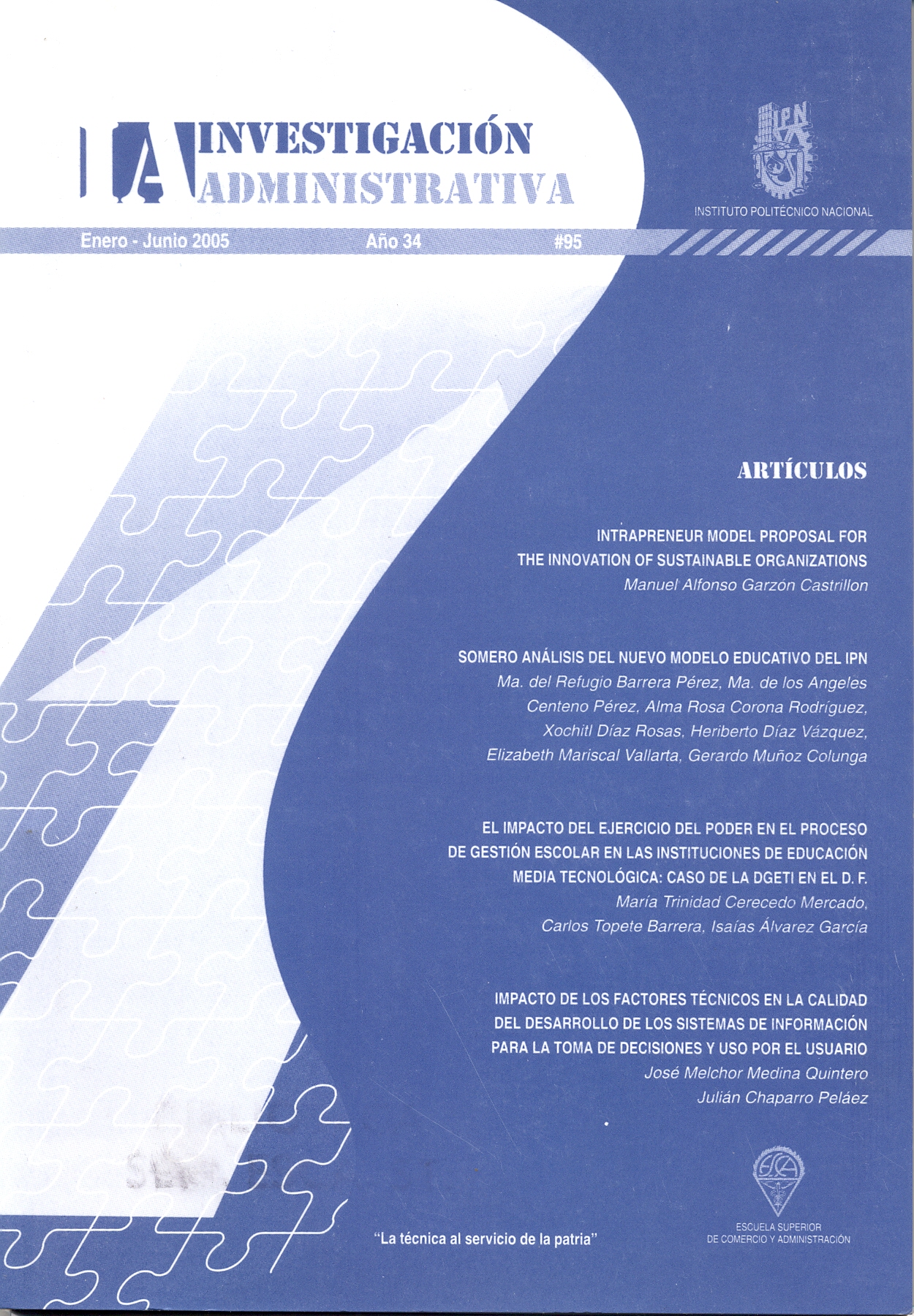IMPACTO DE LOS FACTORES TÉCNICOS EN LA CALIDAD DEL DESARROLLO DE LOS SISTEMAS DE INFORMACIÓN PARA LA TOMA DE DECISIONES Y USO POR EL USUARIO
Contenido principal del artículo
Resumen
Detalles del artículo

Esta obra está bajo una licencia internacional Creative Commons Atribución-NoComercial 4.0.
Citas
Álvarez, R. (2001). It Was a Great System: Face-work and the Discursive Construction of Technology During Information System Development. Information Technology & People (14:4), pp. 385-405.
Auer, T; M. Rouhonen (1997). Analysing the Quality of IS Use and Management in the Organizational Context: Experiences from Two Cases. Information Resources Management Journal (10:3), pp. 18-27.
Azari, R.; J.B. Pick (2005). Technology and Society: Socioeconomic Influences on Technological Sectors for United Sates Countries. International Journal of Information Management (25:1), pp. 21-37.
Bajaj, A.; S.R. Nidumolu (1998). A Feedback Model to Understand Information System Usage. Information & Management (33:4),
pp. 213-224.
Ballou, D.; R. Wang; H. Pazer; G.K. Tayi (1998). Modeling Information Manufacturing Systems to Determine Information Product Quality. Management Science (44:4), pp. 462-484.
Balsamo, S.; A. Di Marco; P Inverardi; M. Simeón (2004). Model-Based Performance Prediction in Software Development: A Survey. IEEE Transactions on Software Engineering (30:5), pp. 295-310.
Barclay, D.; C. Higgins; R. Thompson (1995). The Partial Least Squares (PLS) Approach to Causal Modeling: Personal Computer Adoption and Use as an Illustration. Technology Studies, Special Issue on Research Methodology (2:2), pp. 285-309.
Bennatan, E.M. (2000). On Time Within Budget. Software Management Practices and Techniques, John Wiley and Sons Inc. Editorial. Third Edition, U.S.A.
Boon, O.; C. Wilkin; B. Corbitt (2003). Towards a Broader Bases IS Success Model
- Integrating Critical Success Factors and the DeLone and McLean’s IS Success Model. SWP 2003/10, Faculty of Business and Law. University Deakin. Australia.
Brynjolfsson, E.; L. Hitt (1995). The Productive Keep Producing - Successful Companies Support Good Business Plans with Bight Information Technologies. Information Week. Pág. 18. Cepeda, C.G.; J.L. Roldán (2004). Aplicando en la Práctica la Técnica PLS en la Administración de Empresas. Presentado en ACEDE 2004. Murcia, España, Septiembre 19-21.
Chin, W.W. (1998). Issues and Opinion on Structural Equation Modeling. MIS Quarterly (22:1), pp. vii-xvi
Chow, T.S. (1985). Software Ouality: Definitions, Measurements and Applications. Tutorial on Software Ouality Assurance: A Practical Approach. Silver Spring, MD: IEEE Computer Society Press, pp. 13-20.
Connolly, T; B. Thorn (1987). Predecisional Information Acquisition: Effects of Task Variables on Suboptimal Search Strategies. Organizational Behavior and Human Decision Processes (39:3), pp. 397-417.
Cornelia, A. (1994). Los Recursos de Información. Ventaja Competitiva de las Empresas, McGraw- Hill Editorial, Madrid, España.
Dalcher, D. (2004). Stories and Histories: Case Study Research (and Beyond) in Information Systems Failures. En: Michael E. Whitman and Amy B. Woszczynski (Eds.), The Handbook of Information Systems Research, Idea Group Publishing. Hershey, PA. U.S.A., pp. 305-322.
Davis, F.D. (1989). Perceived Usefulness, Perceived Ease of Use, and User Acceptance of Information Technology. MIS Quarterly (13:3), pp. 319-340.
Hamill, J.T.; R.F. Deckro; J.M. Kloeber Jr. (2005). Evaluating Information Assurance Strategies. Decision Support Systems (39:3), pp. 463-484. Harter,
D.E.; M.S. Krishnan; S.A. Slaughter (2000). Effects of Process Maturity on Quality, Cycle Time, and Effort in Software Product Development. Management Science (46:4), pp. 451-466.
Hartwick, J.; H. Barki (1994). Explaining the Pole of User Participation in Information Systems Use. Management Science (40:4), pp. 440-465.
Herndon, M.A.; R. Moore; M. Phillips; J. Walker and L. West (2003). Interpreting Capability Maturity Model Integration (CMMI) for Service Organizations - a Systems Engineering and Integration Services Example. Software Engineering Process Management. Software Engineering Institute.
Huber, G.P.; R.R. McDaniel (1989). The Decision- Making Paradigm of Organizational Design. Management Science (32:5), pp. 572-589.
Hull, M.E.C.; PS. Taylor; J.R.P. Hanna; R.J. Millar (2002). Software Development Processes - An Assessment. Information and Software Technology (44:1), pp. 1-12.
Igbaria, M.; T. Guimaraes; G.B. Davis (1995). Testing the Determinants of Microcomputer Usage via a Structural Equation Model. Journal of Management Information Systems (11:4), pp. 87-114.
Ives, B.; M.H. Olson; J.J. Baroudi (1983). The Measurement of User Information Satisfaction. Communications of the ACM (26:10), pp. 785-793.
Jiang, J.J.; G. Klein; J. Roan; J.T.M. Un (2001).
IS Service Performance: Self-Perceptions and User Perceptions. Information & Management (38:8), pp. 499-506.
Juran, J.M.; A.B. Godfrey (1999). Juran’s Quality Handbook, 5th Edition. McGraw Hill, New York, U.S.A.
Kahn, B.K.; D.M. Strong; R.Y. Wang (2002). Information Quality Benchmarks: Product and Service Performance. Communications of the ACM (45:4), pp. 184-192.
Straub, D.; C. Carlson (1989). Validating Instrument in MIS Research. MIS Quarterly (13:2), pp. 147-169.
Straub, D.; M. Limayem; E. Karahanna-Evaristo (1995). Measuring System Usage: Implications for IS Theory Testing. Management Science (41:8), pp. 1328-1342.
Teng, J.T.C.; K.J. Calhoun (1996). Organizational Computing as a Facilitator for Operational and Managerial Decision Making: An Exploratory Study of Managers’ Perceptions. Decision Sciences (27:4), pp. 673-710.
Tetzeli, R. (1994). Surviving Information Overload. Fortune. July 11, pp. 60-64.
Tzu-Chuan, C.; R.G. Dyson; PL. Powell (1998). An Empirical Study of the Impact of Information
Technology Intensity in Strategic Investment Decisions. Technology Analysis & Strategic Management (10:3), pp. 325-339.
Watson, R.T.; L.F. Pitt; C.B. Kavan (1998). Measuring Information Systems: Lessons from Two Longitudinal Case Studies. MIS Quarterly (22:1), pp. 61-79.
Wilkin, C.; B. Hewett; R. Carr (2004). Exploring the Role of Expectations in Defining Stakeholders’ Evaluations of IS Quality. En: Wim van Grembergen (Ed./ Information Systems Evaluation Management, pp. 231-243.
IRM Press. London, United Kingdom.
WITSA (World Information Technology and Services Alliance (2000). Digital Planet 2000: The Global Information Economy. Bases on Research Conducted by International Data Corporation (IDC), Published by WITSA.
Wixom, B.H.; H.J. Watson (2001). An Empirical Investigation of the Factors Affecting Data Warehousing Success. MIS Quarterly (25:1), pp. 17-41.
Yuthas, K.; S.T. Young (1998). Material Matters: Assessing the Effectiveness of Materials Management IS. Information & Management (33:3), pp. 115-124.

